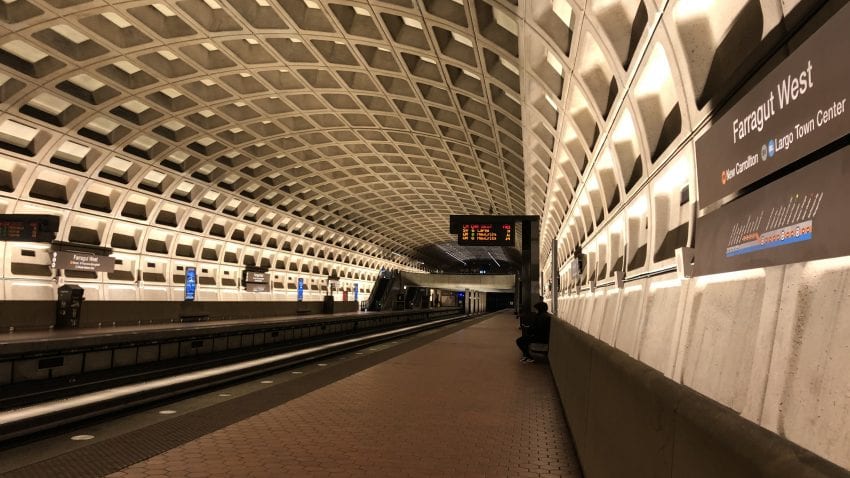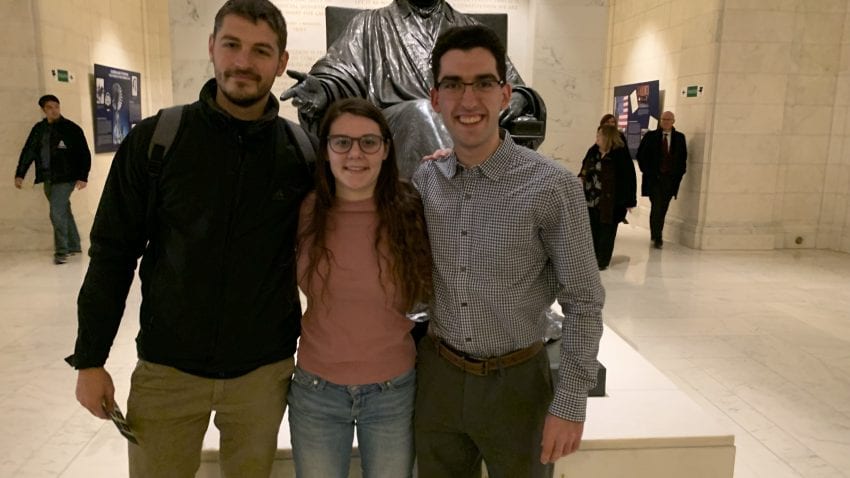
The Library of Congress at night
January 22 was an early morning with the alarm blaring at 4:30, but that was of little importance given the excitement I felt at the prospect of listening to oral arguments at the US Supreme Court. After a quick shower, Mary Crawford and I met at our hotel to proceed to catch the 5 am metro at Farragut West metro station. As we arrived, it became clear that the eerily empty metro station wasn’t due for a train for 20 minutes because the first train left the station at 5 am!

One of the Metro Stations
We were unconcerned, because online research informed us a 6:00 arrival would guarantee admission and a tour guide the week earlier had mentioned even 7:00 would likely guarantee a seat for the entirety of arguments. After arriving at the line however we were slightly more concerned.
Montana V. Espinoza, the case of the day, was seemingly more popular than anticipated. There were around 40 people who had been paid to wait and hold places in line overnight, as well as a school group from Montana already towards the front of the line taking up many spots. While the line was long, and wrapped around the corner, at least we had a good view while we waited and the sun came up!

Library of Congress
Beginning at around 7:30, the security at the Supreme Court began to suggest we would be allowed inside soon. Needless to say we were standing outside in 22 degree weather until 10:00.
The Supreme Court has 2 types of passes to allow viewing. The first is available to the first 50 to 70 people in line (which we were not) and allows them to watch the entire argument. The next 80 or so people in line get what are called “3 minute passes” where they are allowed to walk into the back of the chamber and listen from behind a curtain. Mary and I were given 3 minute passes and accepted that experience would be worthwhile as well but couldn’t help but be disappointed slightly.
We lined up outside the courtroom and waited for our 3 minutes when the security came and said there were 9 more empty chairs, and the first 9 3 minute passes could have them. Mary and I were number 10 and 11. They returned and said one more seat was available, which Mary took as a result of a coin flip.
If Dr. Epstein has taught me one thing during this trip, it is that it doesn’t hurt to ask. I asked the guard if I would have to leave after 3 minutes and wait for Mary and our 3 new friends who we had spent the previous 4 1/2 hours in line with. I was waved inside and walked into the area for members of the Supreme Court Bar, given a seat in the 5th row, and was the last person to be allowed inside!
After listening to the case, Mary and I took the opportunity to get a picture with our German friend Flo!

Mary, our German friend Flo, and I
Listening to the case was fascinating, and it was immediately clear to me that the 8 justices who participated were among the quickest thinking and most insightful people I had ever been in a room with. Clarence Thomas continued his long standing practice of not asking questions to attorneys from either side, and I did not have the opportunity to hear him speak.
The case focused on a clause in the Montana State Constitution banning state funds from flowing to religious purposes and a scholarship fund passed by the Montana legislature which could subsidize students attending private schools, including religious ones. I would highly recommend reading more about the case.
When the Supreme Court hears a case, the vast majority of the time is spent with justices asking questions of attorneys, who have 30 minutes to present their arguments.
Two lines of questioning were particularly memorable to me, and are also particularly unclear to me. Please feel free to listen to the audio recording of the argument and reach out to me and discuss!
The first was brought up by the one and only Justice Ruth Bader Ginsburg. Montana, in anticipation of the court ruling they were discriminating against religious people in denying them access to education funding, discontinued the scholarship fund for everyone. Justice Ginsburg questioned if “equalizing down,” or trying to prevent discrimination by removing any privileges for anyone was advisable or acceptable. The attorneys argued it was the only legal outcome that could maintain the Montana Constitution’s clause maintaining state funds cannot flow to religious institutions, even for non-religious purposes. A comparable, albeit more extreme example would seem to be if the Topeka school district, after the court ordered their schools to desegregate, destroyed the school and denied education to any children. While this would obviously be unproductive, and ill advised, Ginsburg wanted attorneys to argue wether denying anyone education was a legal way to prevent discrimination. The attorneys for the state of Montana did not provide a clear or adequate answer, because the question was extremely difficult.
The second was brought up by the newest member of the bench, Justice Brett Kavanaugh. His line of questioning was added to by several other members including Justice Breyer, Justice Kagan, and Chief Justice Roberts. They wanted counsel for both sides to discuss how the discrimination against religious people should be considered. Is discrimination against religious people and in favor of secular people the same as discrimination based on race, gender, or a particular religion? It intuitively feels different somehow to me, although I believe that feeling is based on 21 years of being told maintaining a separation between church and state is important for both.
The justices questioned counsel based on the notion that had the scholarship fund included clauses that didn’t allow funding for historically black schools, all girls schools, or allowed funding for Catholic but not Jewish schools, the answer would have been extremely clear. The Montana legislature would have clearly been unlawfully discriminating, and the Supreme Court would order the scholarship fund to open to whoever was being discriminated against. The notion that discriminating between religious and secular schools is different, and if so how they are different is a question Kavanaugh asked the attorneys to clarify, but again they did not provide a satisfactory answer.
I will eagerly await the June release of the ruling in Montana V. Espinoza. I don’t know how the justices will rule, but I anticipate their ruling will be quite narrow. I doubt they will address the question of differences or similarities in discriminating between religious and secular groups in comparison to discriminating between whites and people of color, but instead will hear several more cases in the coming years to address that question.
